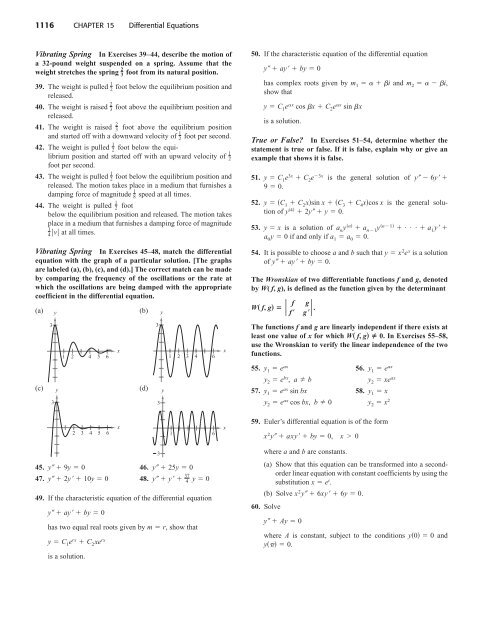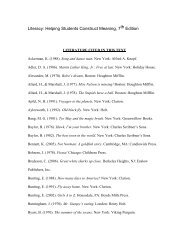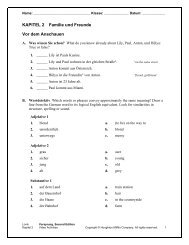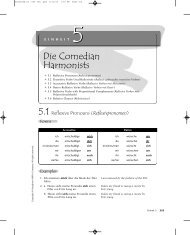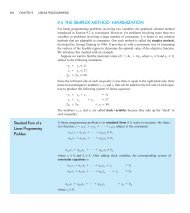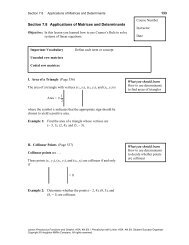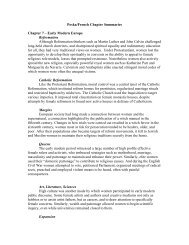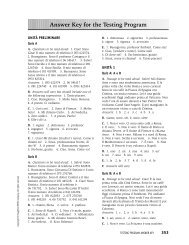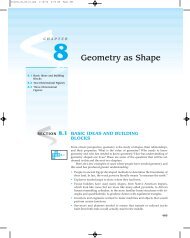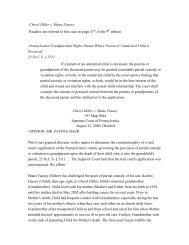Second-Order Linear Differential Equations
Second-Order Linear Differential Equations
Second-Order Linear Differential Equations
Create successful ePaper yourself
Turn your PDF publications into a flip-book with our unique Google optimized e-Paper software.
1116 CHAPTER 15 <strong>Differential</strong> <strong>Equations</strong><br />
Vibrating Spring In Exercises 39–44, describe the motion of<br />
a 32-pound weight suspended on a spring. Assume that the<br />
2<br />
weight stretches the spring foot from its natural position.<br />
39. The weight is pulled 2 foot below the equilibrium position and<br />
released.<br />
2<br />
40. The weight is raised 3 foot above the equilibrium position and<br />
released.<br />
2<br />
41. The weight is raised 3 foot above the equilibrium position<br />
1<br />
and started off with a downward velocity of 2 foot per second.<br />
1<br />
42. The weight is pulled 2 foot below the equi-<br />
1<br />
librium position and started off with an upward velocity of 2<br />
foot per second.<br />
1<br />
43. The weight is pulled 2 foot below the equilibrium position and<br />
released. The motion takes place in a medium that furnishes a<br />
1<br />
damping force of magnitude 8 speed at all times.<br />
1<br />
44. The weight is pulled 2 foot<br />
below the equilibrium position and released. The motion takes<br />
place in a medium that furnishes a damping force of magnitude<br />
1<br />
at all times.<br />
4 v<br />
Vibrating Spring In Exercises 45–48, match the differential<br />
equation with the graph of a particular solution. [The graphs<br />
are labeled (a), (b), (c), and (d).] The correct match can be made<br />
by comparing the frequency of the oscillations or the rate at<br />
which the oscillations are being damped with the appropriate<br />
coefficient in the differential equation.<br />
(a) (b)<br />
3<br />
(c) (d)<br />
3<br />
y<br />
y<br />
1<br />
2<br />
2 3<br />
y 9y 0<br />
45. 46.<br />
47. 48.<br />
y 2y 10y 0<br />
49. If the characteristic equation of the differential equation<br />
y ay by 0<br />
has two equal real roots given by m r, show that<br />
y C 1 e rx C 2 xe rx<br />
is a solution.<br />
4<br />
4<br />
5 6<br />
5 6<br />
1<br />
x<br />
x<br />
3<br />
3<br />
3<br />
3<br />
y<br />
y<br />
1<br />
1<br />
2 3<br />
y y 37<br />
y 25y 0<br />
4<br />
4 y 0<br />
6<br />
6<br />
x<br />
x<br />
50. If the characteristic equation of the differential equation<br />
y ay by 0<br />
has complex roots given by m1 i and m2 i,<br />
show that<br />
y C 1e x cos x C 2e x sin x<br />
is a solution.<br />
True or False? In Exercises 51–54, determine whether the<br />
statement is true or false. If it is false, explain why or give an<br />
example that shows it is false.<br />
51. y C1e is the general solution of<br />
9 0.<br />
3x C2e3x 52. is the general solution<br />
of y4 y C1 C2xsin x C3 C4xcos x<br />
2y y 0.<br />
53. y x is a solution of<br />
a0y 0 if and only if a1 a0 0.<br />
54. It is possible to choose a and b such that y x is a solution<br />
of<br />
2ex y ay by 0.<br />
The Wronskian of two differentiable functions f and g, denoted<br />
by W( f, g), is defined as the function given by the determinant<br />
W f, g f g g .<br />
The functions f and g are linearly independent if there exists at<br />
least one value of x for which W f, g 0. In Exercises 55–58,<br />
use the Wronskian to verify the linear independence of the two<br />
functions.<br />
55. 56.<br />
y 1 e ax<br />
f<br />
y 2 e bx , a b<br />
57. y1 e 58. y1 x<br />
ax sin bx<br />
y 2 e ax cos bx, b 0<br />
59. Euler’s differential equation is of the form<br />
x 2 y axy by 0, x > 0<br />
where a and b are constants.<br />
(a) Show that this equation can be transformed into a secondorder<br />
linear equation with constant coefficients by using the<br />
substitution<br />
(b) Solve x<br />
60. Solve<br />
2 x e<br />
y 6xy 6y 0.<br />
t .<br />
y Ay 0<br />
a n y n a n1 y n1 . . . a 1 y <br />
y 1 e ax<br />
y 2 xe ax<br />
y 2 x 2<br />
y 6y <br />
where A is constant, subject to the conditions y0 0 and<br />
y 0.


